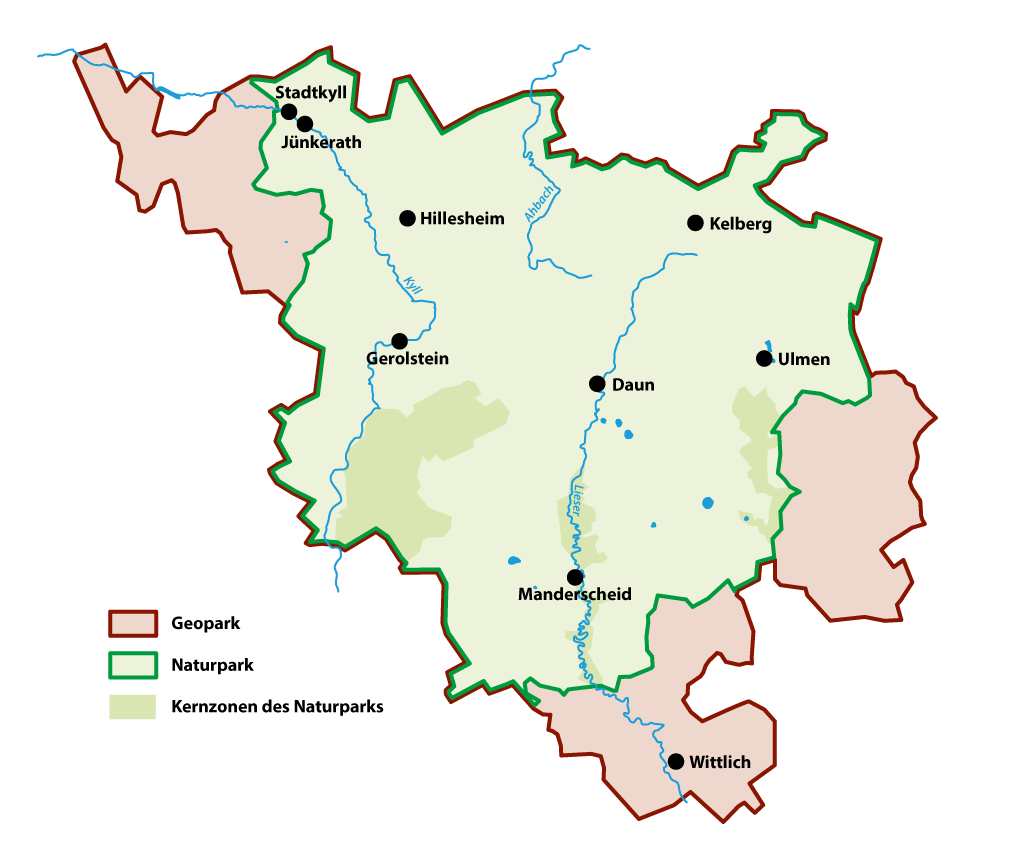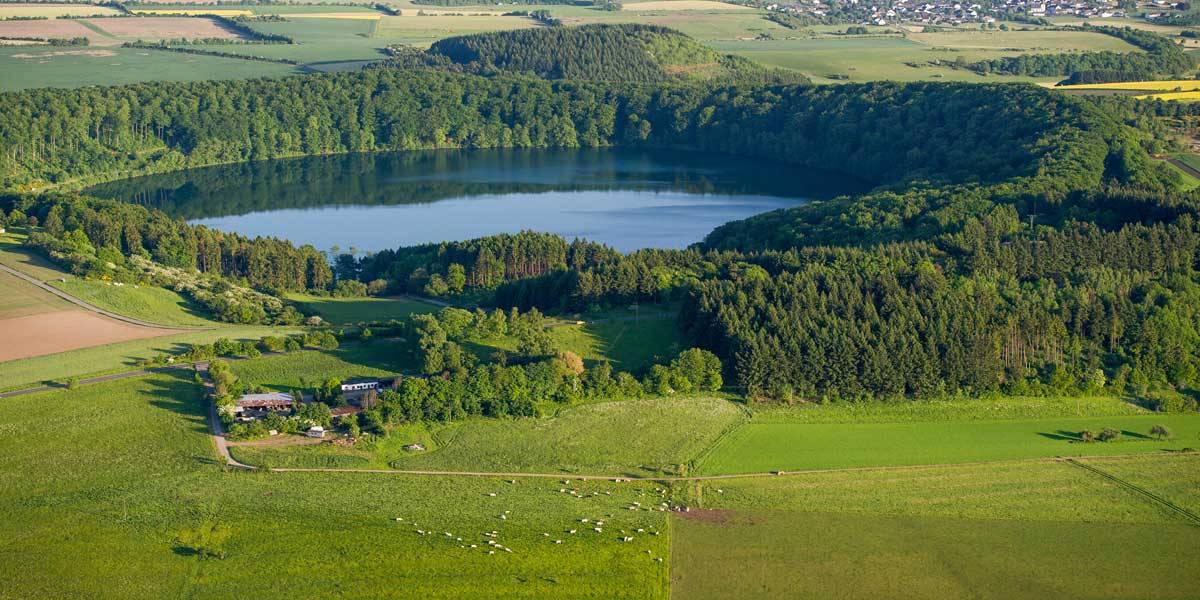On the road in the land of Maars and volcanoes: stretching from the spa town of Bad Bertrich on the Moselle to the Goldberg near Ormont at the Belgian border, a landscape unfolds across the western Eifel that cannot be found anywhere else in Europe or even globally.
UNESCO Geoparks are areas of geological sites and landscapes of international geological significance. Since 2015, this category of UNESCO exists alongside UNESCO World Heritage Sites and Biosphere Reserves.
Geoparks bridge the gap between the Earth's geological past, the formation of the landscape, and the cultures and traditions of the people that have emerged through land use.  They serve as a window to the past and provide perspectives for a sustainable future. Geoparks support the United Nations' global sustainability goals: to enable a decent standard of living worldwide while preserving natural resources in the long term. This includes economic, ecological, and social aspects. The Agenda 2030 underscores the shared responsibility of all stakeholders: politics, economy, science, civil society, and every individual.
They serve as a window to the past and provide perspectives for a sustainable future. Geoparks support the United Nations' global sustainability goals: to enable a decent standard of living worldwide while preserving natural resources in the long term. This includes economic, ecological, and social aspects. The Agenda 2030 underscores the shared responsibility of all stakeholders: politics, economy, science, civil society, and every individual.
Environmental education, climate change, sustainable development, and regional traditions are the focus of our work. It always revolves around people and achieving these goals through partnerships at all levels.
As bottom-up organizations, Geoparks are not legally anchored but are voluntary contributions from their municipalities. Therefore, networking of local actors and the collaboration of all are essential.
Vulkaneifel - Land of Maars and Volcanoes
There is no lava-spewing volcano here at the moment, but the previous volcanic activity has left unmistakable traces, turning the landscape into a textbook of Earth's history. We do not know when there will be another eruption. The geological conditions for it still exist, and volcanologists agree that volcanism in the Eifel has only taken a pause, not extinguished. However, the "West Eifel Volcanic Field" is not only a sought-after destination and subject of various research projects for volcano researchers and geology enthusiasts from around the world but has also captured the attention of many guests from a tourist perspective under the name "Vulkaneifel."
Volcanic cones, mineral water springs, a unique density of natural phenomena, and especially the Maars are the attractions of this landscape in the heart of Europe. With the Dauner Maars, the Mosenberg-Meerfelder Maar volcanic complex and the Dreimühlen waterfall, the Vulkaneifel boasts three geological sites that have been recognised as "Germany's most important geosites". Since 2022, the Ulmener Maar, the youngest volcano in Central Europe, has also been recognised as one of the 100 most important geoheritage sites in the world.
Sustainable Development
The region has made it its mission to connect Earth and geosciences with tourism, sending impulses into various fields, whether it's gastronomy, art, culture, sports, or leisure. With a stronger focus on the geological heritage of the landscape, without losing sight of the integrity of the living nature, the Natur- und Geopark Vulkaneifel aims to contribute to the sustainable development of the region.Vulkaneifel Officially Recognized as UNESCO Global Geopark
In November 2015, UNESCO officially decided: the Natur- und Geopark Vulkaneifel and five other regions in Germany receive recognition as UNESCO Global Geoparks. With the confirmation of the "International Geoscience and Geopark Program" by the UNESCO General Conference, the Natur- und Geopark Vulkaneifel has now reached an international level of recognition, elevating it to the level of World Heritage Sites and Biosphere Reserves.
Back in 2004, with the establishment of the "Global Geoparks" network, UNESCO sent a worldwide signal that geological processes and phenomena on our planet should be more comprehensively included in natural observations than before.
The Vulkaneifel is proud to have been able to carry the UNESCO label of a Global Geopark from the very beginning. Currently, the European Geoparks Network, of which the Natur- und Geopark Vulkaneifel is also a part, includes 94 Geoparks from 28 European countries. In Germany, regions with special Earth history are receiving more attention. Together with the volcanic field of the Osteifel, the Vulkaneifel has been awarded the status of a "national Geopark" by the Alfred Wegener Foundation in conjunction with the Federal Ministry of Education, Science, and Research. The international recognitions as a European and UNESCO Global Geopark are both awards and incentives to further develop the existing activities in the areas of geological public relations, the establishment of geological museums and thematic trails, information boards, protection and preservation of geosites, and the development of geotourism offerings in collaboration with the political and tourist stakeholders of the region.
Naturpark Vulkaneifel Inaugurated in 2010
As the eighth Nature Park in Rhineland-Palatinate, the Naturpark Vulkaneifel was officially inaugurated in a ceremony on May 31, 2010, through the inaugural speech and the appointment of the Nature Park sponsor by Minister Margit Conrad, Ministry of Environment, Forestry and Consumer Protection of Rhineland-Palatinate. The new Nature Park boasts a unique natural quality in the combination of maars, volcanoes, and diverse cultural landscapes. These are excellent conditions for sustainable development, combining environmentally friendly land use with regional added value, nature-based tourism, and economic development.
Year-Round Offerings
The regional Museums as well as hiking trails with different geological focuses such as volcanism, Devonian and Buntsandstein, mineral water, or Middle Devonian limestones, as well as the Eifelsteig, the extended Vulkaneifel trails, and cycling routes lead to the geological treasures of the Vulkaneifel. In 2008, the "German Volcano Route" was established, which extends beyond the Vulkaneifel to the volcanic Osteifel around Laacher See volcano, connecting the volcanic landscapes of the entire Eifel shaped by volcanism. Guided hikes, excursions, and special events on geoscientific topics, as well as numerous nature experiences, are offered year-round.

